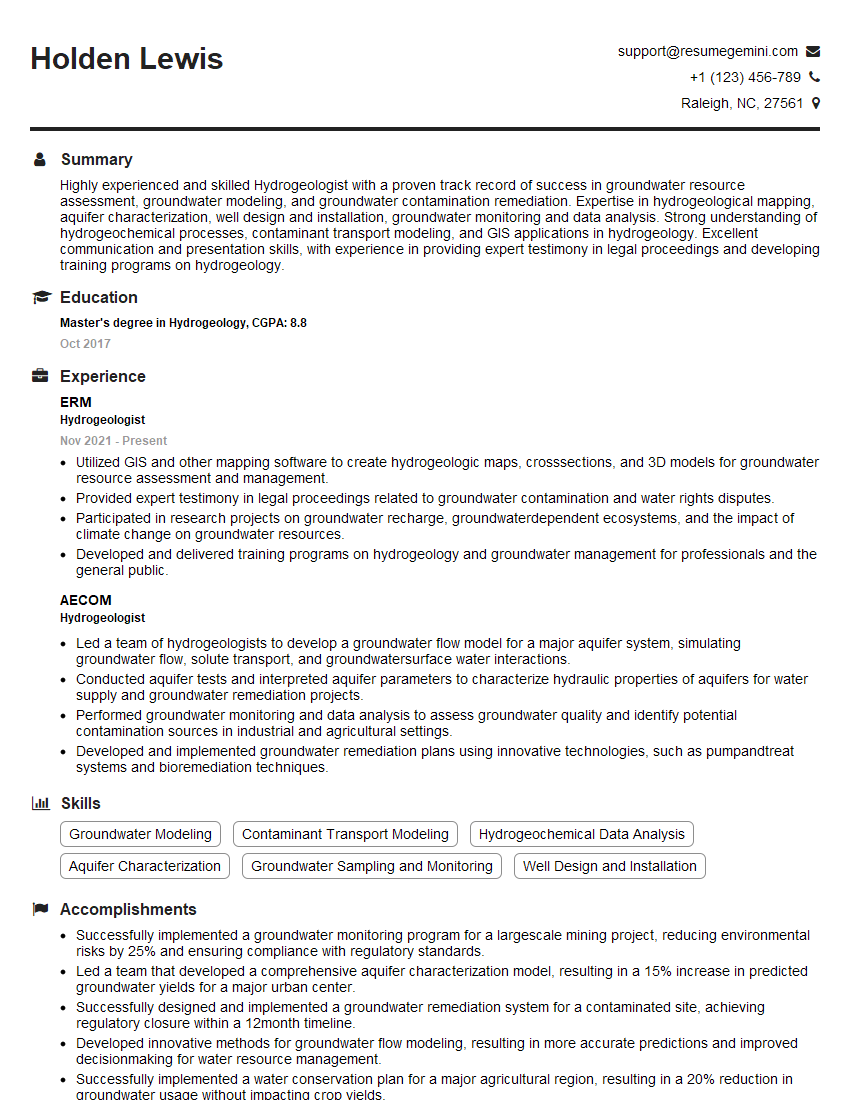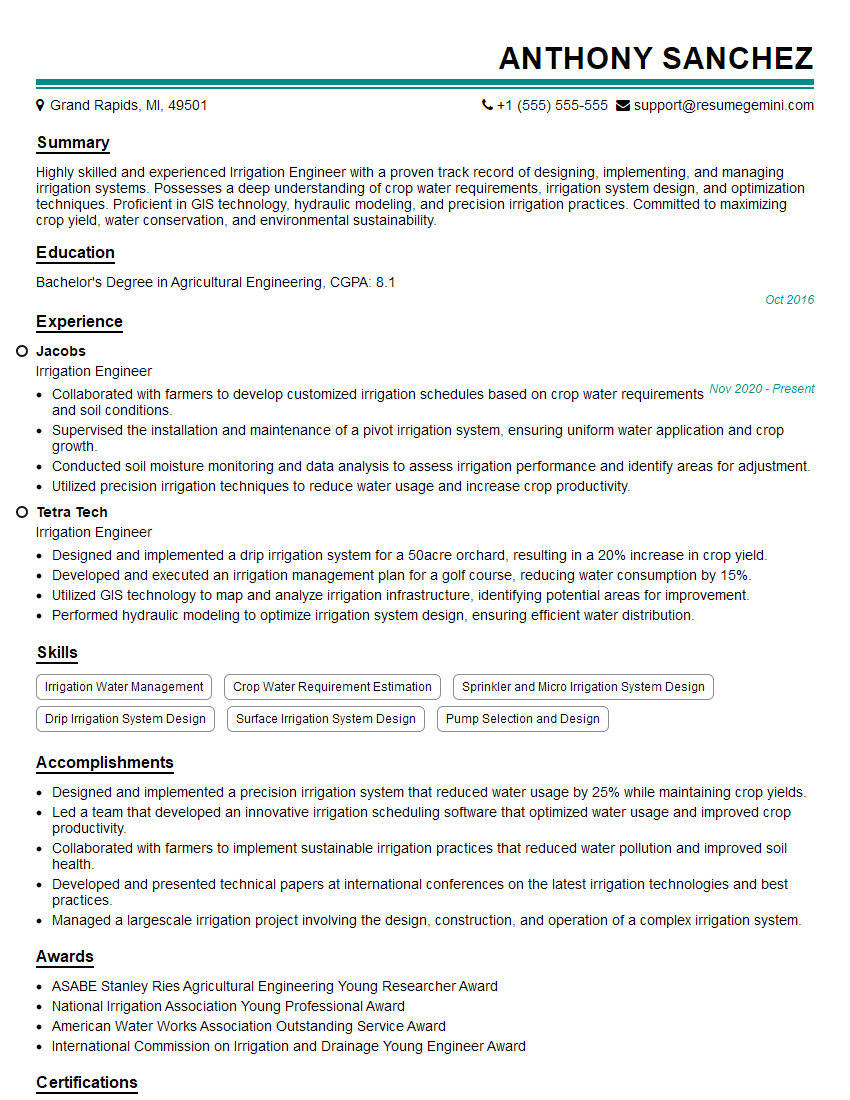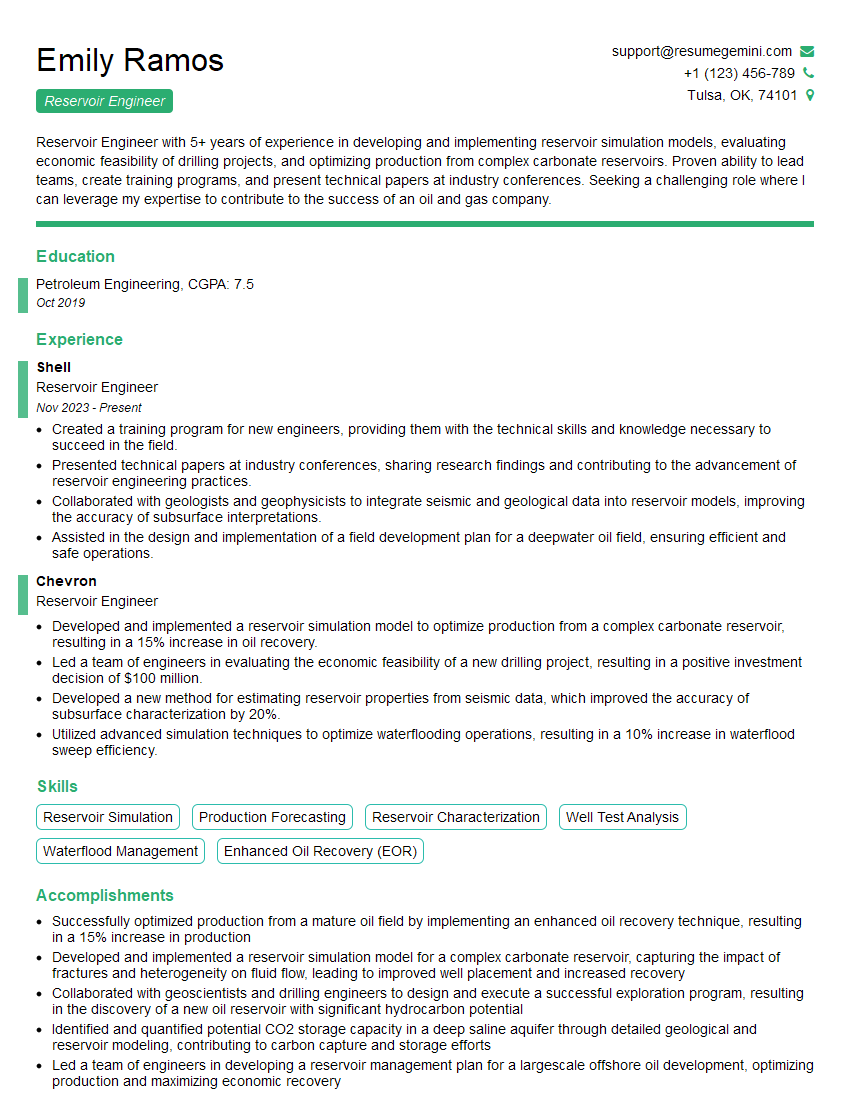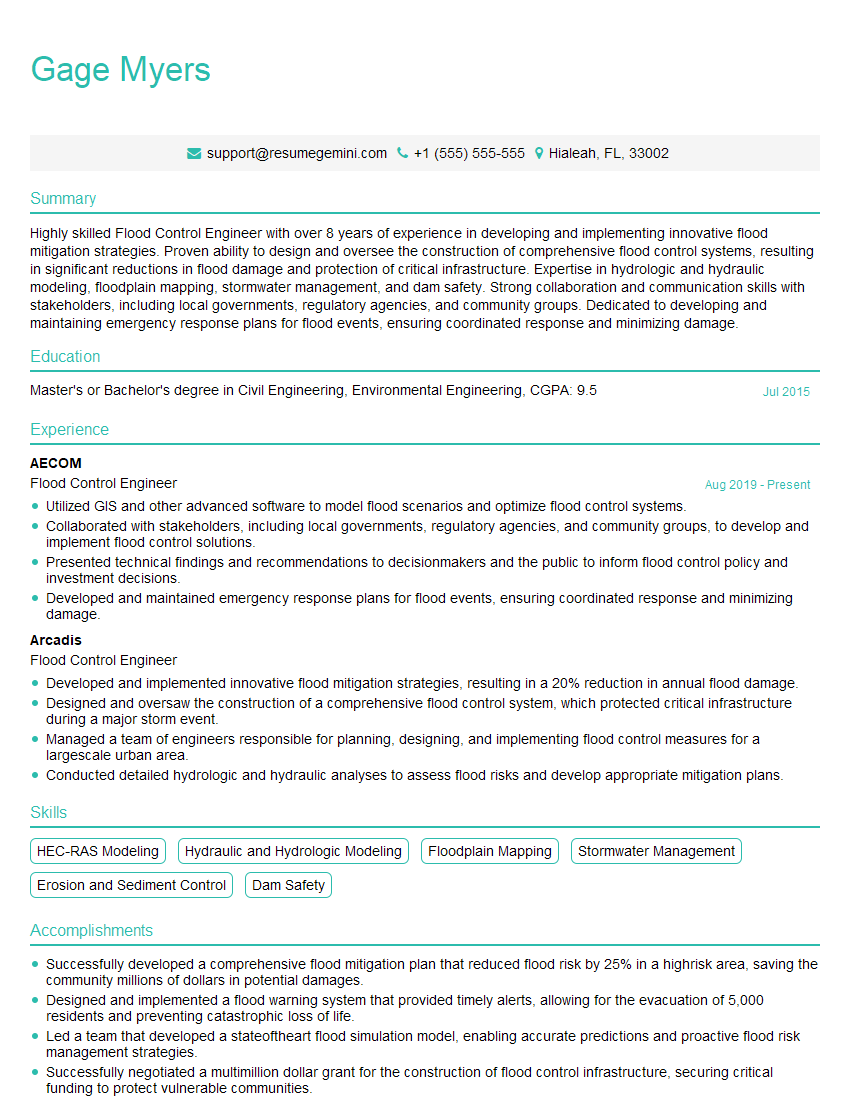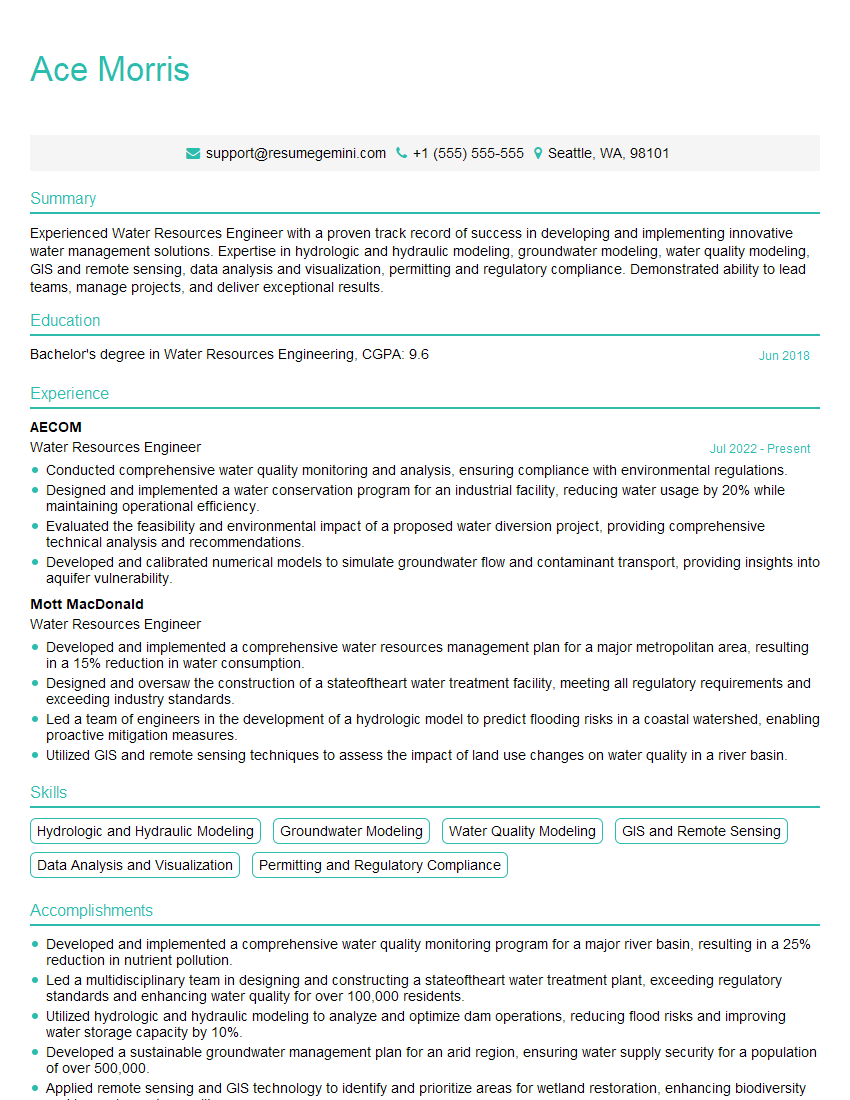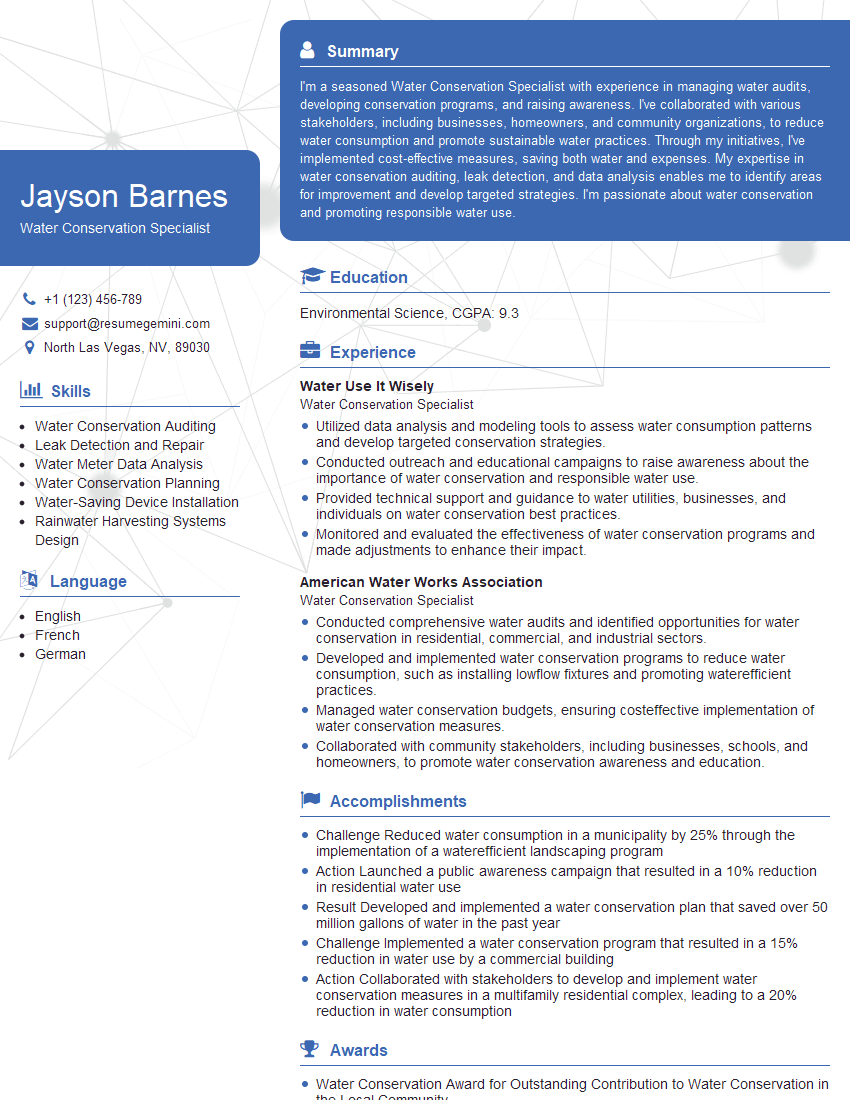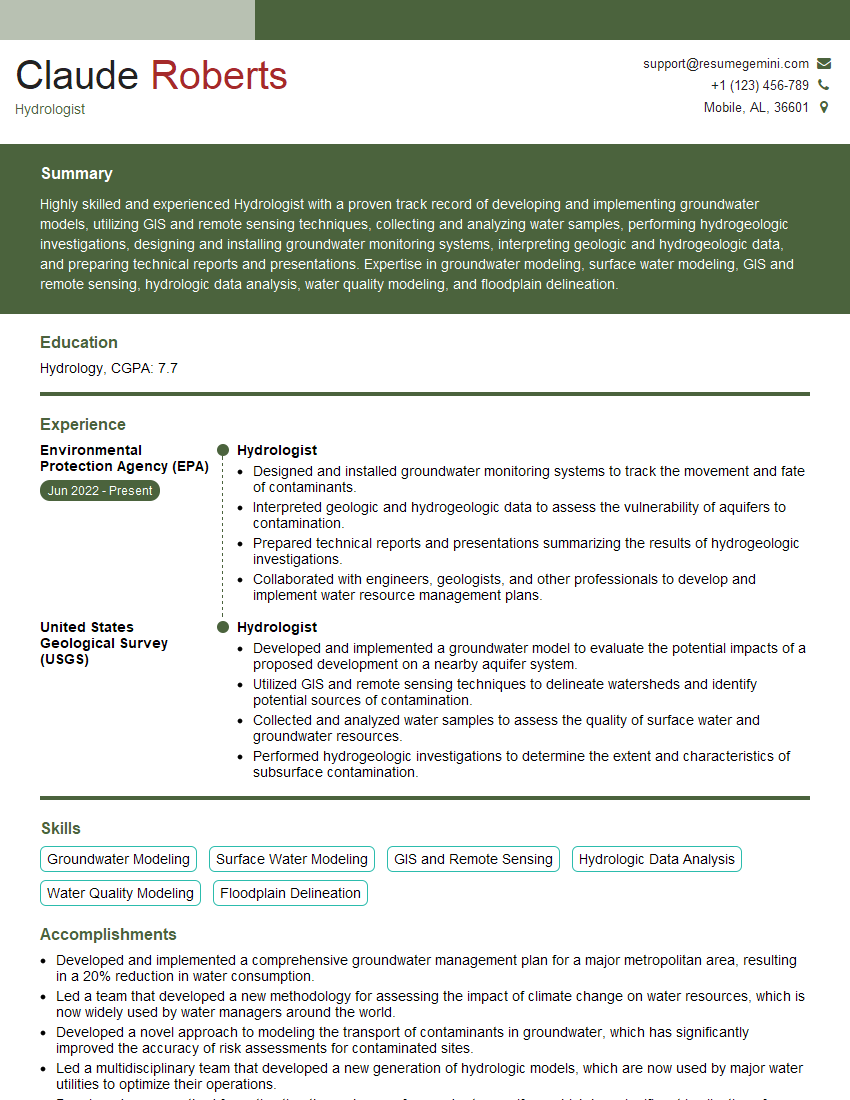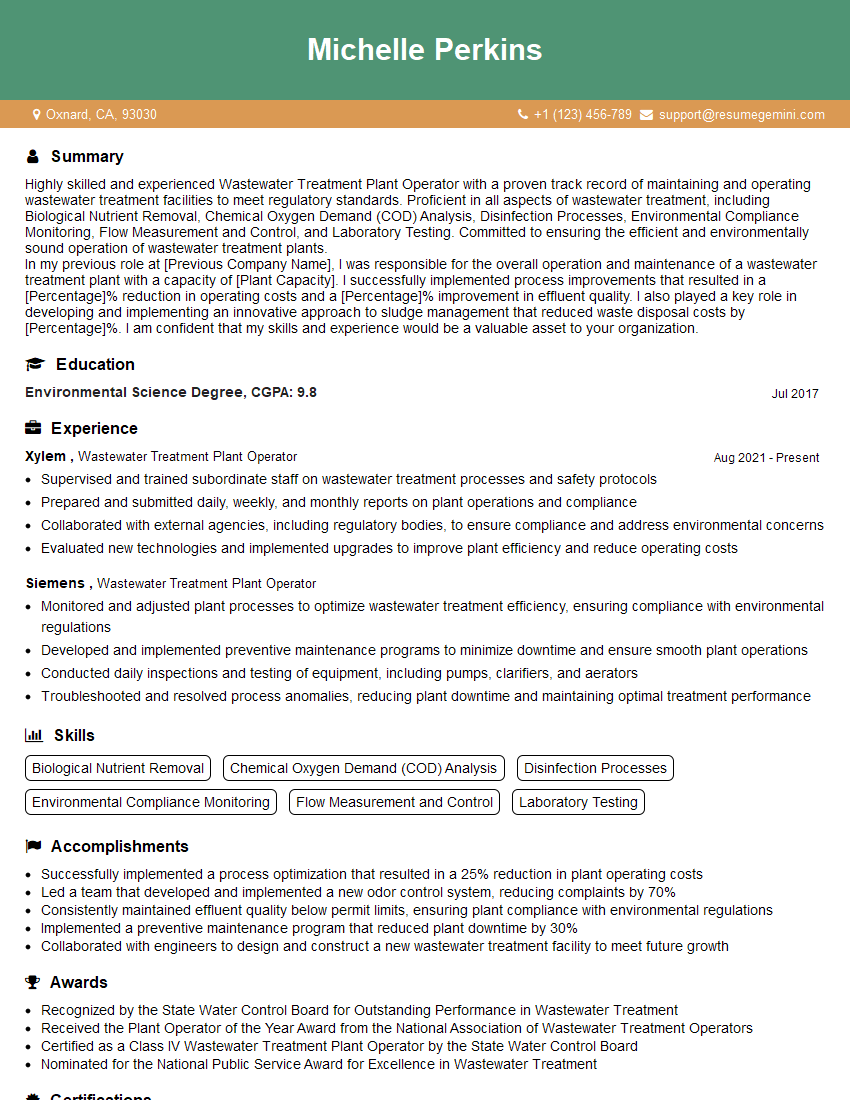Unlock your full potential by mastering the most common Water Cycle Management interview questions. This blog offers a deep dive into the critical topics, ensuring you’re not only prepared to answer but to excel. With these insights, you’ll approach your interview with clarity and confidence.
Questions Asked in Water Cycle Management Interview
Q 1. Explain the key components of the hydrological cycle.
The hydrological cycle, also known as the water cycle, is the continuous movement of water on, above, and below the surface of the Earth. Think of it as a giant, global recycling system for water. It’s driven by solar energy and gravity. Key components include:
- Evaporation: The transformation of water from liquid to gas (water vapor), primarily from oceans, lakes, and rivers, powered by the sun.
- Transpiration: The release of water vapor from plants into the atmosphere. Imagine plants ‘breathing’ out water vapor.
- Evapotranspiration: The combined effect of evaporation and transpiration. This is a crucial component in understanding water availability in a region.
- Condensation: The transformation of water vapor back into liquid water, forming clouds. Think of the water vapor in your breath forming a cloud on a cold day.
- Precipitation: Water falling from the atmosphere in the form of rain, snow, sleet, or hail. This is how water returns to the Earth’s surface.
- Infiltration: The process of water seeping into the ground, replenishing groundwater stores. This is essential for aquifers and wells.
- Runoff: Water flowing over the land surface, eventually making its way to rivers, lakes, and oceans. This is what causes rivers to flow.
- Groundwater flow: The slow movement of water underground through porous rocks and soil.
Understanding these components is crucial for managing water resources effectively. For example, knowing the evapotranspiration rate helps in designing efficient irrigation systems, while understanding infiltration patterns is key to managing groundwater extraction.
Q 2. Describe different types of water pollution and their sources.
Water pollution is the contamination of water bodies (e.g., rivers, lakes, oceans, groundwater) with harmful substances that negatively impact water quality and aquatic life. Types of pollution include:
- Point Source Pollution: Pollution from a single, identifiable source, such as a factory discharge pipe or a sewage treatment plant. This is easier to monitor and regulate.
- Non-point Source Pollution: Pollution from diffuse sources, like agricultural runoff (fertilizers and pesticides), urban stormwater runoff (oil, litter), or atmospheric deposition (acid rain). This is harder to track and control.
Specific Pollutants and Sources:
- Pathogens (bacteria, viruses): Sewage, animal waste.
- Nutrients (nitrogen, phosphorus): Fertilizers, sewage.
- Heavy metals (lead, mercury): Industrial discharge, mining.
- Pesticides: Agricultural runoff.
- Oil: Spills, runoff from roads.
- Plastics: Improper waste disposal.
The consequences of water pollution can be devastating, including harming aquatic ecosystems, making water unsafe for drinking and recreation, and affecting human health. Effective water pollution control requires a multi-pronged approach addressing both point and non-point sources.
Q 3. What are the common methods for water treatment?
Water treatment methods aim to remove contaminants and make water safe for human consumption and other uses. Common methods include:
- Coagulation and Flocculation: Chemicals are added to clump together small particles, making them easier to remove.
- Sedimentation: Allowing larger particles to settle out of the water.
- Filtration: Passing water through various filter media (sand, gravel, charcoal) to remove suspended solids.
- Disinfection: Using chlorine, ultraviolet light, or ozone to kill harmful microorganisms.
- Fluoridation (optional): Adding fluoride to improve dental health.
The specific methods used depend on the initial water quality and the desired level of treatment. For example, a simple filtration system might suffice for rainwater harvesting in a rural area, while a complex multi-stage treatment plant is needed for municipal water supplies.
Q 4. Explain the principles of sustainable water management.
Sustainable water management aims to meet present water needs without compromising the ability of future generations to meet their own needs. Key principles include:
- Integrated Water Resources Management (IWRM): A holistic approach that considers all aspects of water use and management within a watershed, balancing competing demands.
- Water Conservation: Reducing water consumption through efficient technologies and practices (e.g., low-flow showerheads, drip irrigation).
- Water Reuse and Recycling: Treating wastewater for reuse in agriculture or industry.
- Water Pricing: Implementing cost-reflective pricing mechanisms to encourage conservation.
- Protection of Water Quality: Preventing pollution through effective regulations and enforcement.
- Community Participation: Engaging local communities in decision-making processes.
Sustainable water management requires a shift from a traditional approach focusing solely on supply augmentation to one that emphasizes demand management and the protection of water resources.
Q 5. How do you assess the water quality of a given source?
Assessing water quality involves analyzing various physical, chemical, and biological parameters. Methods include:
- Physical parameters: Temperature, turbidity (cloudiness), color, odor.
- Chemical parameters: pH, dissolved oxygen, nutrients (nitrogen, phosphorus), heavy metals, pesticides, salinity.
- Biological parameters: Presence of indicator organisms (e.g., E. coli) which suggest fecal contamination, presence of algae or other aquatic organisms.
Water quality is often assessed using standardized methods and indices, such as the Water Quality Index (WQI). Laboratory testing is often required for accurate analysis of chemical and biological parameters. For example, a high concentration of E. coli indicates fecal contamination and makes the water unsafe for drinking. The selection of parameters for testing depends on the intended use of the water and potential sources of contamination.
Q 6. What are the different types of irrigation systems and their efficiencies?
Irrigation systems deliver water to crops, and their efficiency varies greatly. Types include:
- Flood irrigation: Flooding fields with water; low efficiency due to high water loss through evaporation and runoff.
- Furrow irrigation: Water flows in furrows between crop rows; moderately efficient, better than flood irrigation.
- Drip irrigation: Water is delivered directly to plant roots through small tubes; highly efficient, minimizing water loss.
- Sprinkler irrigation: Water is sprayed over the field; efficiency depends on nozzle design and wind conditions.
- Subsurface drip irrigation: Similar to drip but with the tubing buried underground; very efficient, reducing evaporation loss.
Efficiency is measured by the proportion of water applied that is actually used by plants. Drip irrigation has the highest efficiency (often above 90%), while flood irrigation is the least efficient (often below 50%). Choosing the right system depends on factors like climate, soil type, crop type, and water availability.
Q 7. Describe the role of GIS in water resource management.
Geographic Information Systems (GIS) are powerful tools for water resource management. They allow for spatial analysis and visualization of water-related data. GIS applications include:
- Mapping water resources: Showing the location of rivers, lakes, aquifers, and wells.
- Modeling water flow: Simulating the movement of water through a watershed.
- Assessing water quality: Mapping pollution sources and monitoring changes in water quality over time.
- Planning water infrastructure: Identifying optimal locations for dams, reservoirs, and pipelines.
- Managing droughts and floods: Assessing flood risk and identifying areas vulnerable to drought.
For instance, GIS can be used to model the impact of a proposed dam on downstream water flow and quality. The visualization capabilities of GIS enable better communication and stakeholder engagement in water management planning. Essentially, GIS provides a powerful platform to integrate and analyze diverse water-related data, leading to improved decision-making.
Q 8. How do you model water flow in a watershed?
Modeling water flow in a watershed involves using hydrological models to simulate the movement of water through the system. These models consider various factors like precipitation, evapotranspiration, infiltration, runoff, and groundwater flow. Different models exist, ranging from simple empirical equations to complex physically-based simulations.
For example, a simple model might use the Rational Method to estimate peak runoff from a small watershed, considering rainfall intensity, drainage area, and runoff coefficient. More sophisticated models like SWAT (Soil and Water Assessment Tool) or MIKE SHE incorporate detailed spatial data and simulate processes across different components of the watershed, including soil moisture, vegetation, and channel flow. These often require GIS software and significant computational power.
The choice of model depends on the specific goals of the study, data availability, and the level of detail required. A simple model might suffice for a preliminary assessment, while a complex model is necessary for detailed water resource management planning, such as assessing the impact of land-use changes or climate change on water availability.
Q 9. Explain the concept of water footprint.
The water footprint represents the total volume of freshwater used to produce goods and services consumed by a person or a community. It encompasses three main components:
- Blue water footprint: The volume of freshwater withdrawn from surface or groundwater sources (e.g., for irrigation, industrial processes).
- Green water footprint: The volume of rainwater evaporated from soil during crop production. This isn’t directly withdrawn but is still consumed by the system.
- Grey water footprint: The volume of freshwater needed to assimilate pollutants associated with production processes. This represents the water required for dilution of wastewater to meet environmental standards.
For instance, a cotton t-shirt has a significant water footprint due to the large amounts of water needed for irrigation in cotton farming. Similarly, beef production has a very large water footprint, primarily due to the high water demand of raising cattle for feed and the water needed to process the beef. Understanding water footprints helps us assess the sustainability of consumption patterns and identify areas where water-saving measures can be implemented.
Q 10. What are the challenges in managing groundwater resources?
Managing groundwater resources presents several significant challenges:
- Over-extraction: Excessive pumping can deplete aquifers faster than they can recharge, leading to land subsidence, saltwater intrusion in coastal areas, and reduced water availability.
- Pollution: Groundwater is vulnerable to contamination from various sources, including industrial discharge, agricultural runoff, and leaking septic systems. Contamination can be difficult and expensive to remediate.
- Data scarcity: Accurate information on groundwater levels, quality, and recharge rates is often limited, hindering effective management decisions.
- Governance and institutional capacity: Effective groundwater management often requires strong institutions, clear regulations, and community participation, which can be lacking in many regions.
- Climate change impacts: Changes in precipitation patterns and increased evaporation can significantly affect groundwater recharge and availability.
For example, the Ogallala Aquifer in the United States has experienced significant depletion due to over-extraction for irrigation, highlighting the need for sustainable groundwater management strategies.
Q 11. Describe different water conservation techniques.
Water conservation techniques encompass various strategies aimed at reducing water consumption and improving efficiency. These can be categorized into:
- Improved irrigation techniques: Drip irrigation, micro-sprinklers, and rainwater harvesting reduce water losses and improve water use efficiency in agriculture.
- Water-efficient appliances: Low-flow showerheads, toilets, and washing machines reduce water usage in households.
- Industrial water reuse and recycling: Treating and reusing wastewater for industrial processes minimizes freshwater withdrawals.
- Leak detection and repair: Regularly inspecting and repairing leaks in water distribution systems reduces water losses.
- Public awareness campaigns: Educating the public about water conservation practices and their importance promotes responsible water use.
- Water pricing strategies: Implementing tiered water pricing systems can incentivize consumers to conserve water.
For instance, the city of Singapore has implemented strict water conservation measures, including water rationing during dry periods and a robust public education campaign, achieving remarkable success in water management.
Q 12. How do you manage flood risks in urban areas?
Managing flood risks in urban areas requires a multi-faceted approach involving:
- Improved drainage systems: Expanding and upgrading stormwater drainage infrastructure to handle increased runoff during intense rainfall events.
- Green infrastructure: Incorporating green spaces, such as parks, wetlands, and permeable pavements, to absorb and infiltrate stormwater, reducing runoff volume.
- Flood control structures: Constructing dams, levees, and retention basins to manage floodwaters and prevent inundation of urban areas.
- Flood warning systems: Implementing early warning systems to alert residents about impending floods, providing time for evacuation and preparedness.
- Land-use planning and zoning: Restricting development in flood-prone areas and implementing building codes to mitigate flood damage.
- Community preparedness and education: Educating the public about flood risks and developing community-based flood preparedness plans.
For example, many cities are adopting sponge city approaches, using green infrastructure to reduce urban flooding and improve water management.
Q 13. Explain the impact of climate change on the water cycle.
Climate change significantly impacts the water cycle, resulting in changes to precipitation patterns, increased evaporation rates, and altered snow and ice melt. These changes can lead to:
- Increased frequency and intensity of floods and droughts: More extreme rainfall events cause more frequent and severe floods, while prolonged periods of low rainfall lead to more intense and prolonged droughts.
- Changes in water availability: Altered precipitation patterns affect surface water resources and groundwater recharge, impacting water availability for various sectors.
- Sea-level rise: Rising sea levels lead to saltwater intrusion into coastal aquifers and increased risk of coastal flooding.
- Changes in water quality: Altered precipitation and runoff patterns can impact water quality, potentially increasing the concentration of pollutants.
These changes necessitate adapting water management strategies to ensure water security under a changing climate. This includes investing in water storage and conservation measures, improving water use efficiency, and developing drought-resistant crops.
Q 14. What are the common methods for stormwater management?
Common methods for stormwater management aim to reduce the volume and velocity of runoff, improve water quality, and mitigate flooding. These methods include:
- Retention and detention basins: These engineered structures temporarily store stormwater, allowing it to infiltrate or slowly release into the environment.
- Green infrastructure: This includes techniques like rain gardens, bioswales, and permeable pavements which absorb and infiltrate stormwater, mimicking natural processes.
- Constructed wetlands: These artificial wetlands filter pollutants from stormwater before it reaches receiving waters.
- Stormwater harvesting: Collecting and storing stormwater for beneficial uses like irrigation or toilet flushing.
- Low impact development (LID): A collection of site design strategies that minimize impervious surfaces and maximize infiltration and evapotranspiration to reduce runoff.
- Source control measures: Implementing measures to reduce pollution at its source, such as preventing fertilizers and pesticides from entering stormwater systems.
For example, many cities are increasingly integrating green infrastructure into their stormwater management systems, reducing runoff and improving water quality in urban environments.
Q 15. Describe the role of dams in water resource management.
Dams play a crucial role in water resource management by acting as storage reservoirs, controlling water flow, and generating hydropower. Think of them as giant bathtubs for rivers. They regulate water supply for various purposes, including irrigation, drinking water, and industrial use. They also mitigate flood risks by storing excess water during heavy rainfall and releasing it gradually.
However, dams are not without their drawbacks. The construction of a dam can significantly alter the natural flow regime of a river, impacting downstream ecosystems. The formation of a reservoir behind a dam can lead to habitat loss and changes in water temperature and quality. For example, the construction of the Three Gorges Dam in China resulted in the displacement of millions of people and significant ecological changes to the Yangtze River ecosystem. Careful planning, environmental impact assessments, and stakeholder consultations are crucial for the sustainable management of dams.
- Water Supply Regulation: Dams store water during periods of high rainfall and release it during dry seasons, ensuring a consistent supply for human needs and agriculture.
- Flood Control: By storing excess water, dams reduce the risk and severity of downstream floods, protecting lives and property.
- Hydropower Generation: Many dams incorporate hydropower facilities, providing clean and renewable energy.
- Navigation Improvement: Dams can create deeper waterways, improving navigation for ships and barges.
Career Expert Tips:
- Ace those interviews! Prepare effectively by reviewing the Top 50 Most Common Interview Questions on ResumeGemini.
- Navigate your job search with confidence! Explore a wide range of Career Tips on ResumeGemini. Learn about common challenges and recommendations to overcome them.
- Craft the perfect resume! Master the Art of Resume Writing with ResumeGemini’s guide. Showcase your unique qualifications and achievements effectively.
- Don’t miss out on holiday savings! Build your dream resume with ResumeGemini’s ATS optimized templates.
Q 16. How do you evaluate the environmental impact of water projects?
Evaluating the environmental impact of water projects requires a holistic and multidisciplinary approach. It involves a rigorous assessment of potential impacts on various environmental components, such as water quality, aquatic ecosystems, terrestrial ecosystems, and air quality. We use several methodologies:
- Baseline Studies: These establish the pre-project environmental conditions, which serve as a benchmark against which post-project conditions can be compared.
- Impact Prediction Models: Sophisticated models, often based on Geographic Information Systems (GIS), are used to predict potential impacts, accounting for various factors such as flow alterations, sedimentation, and water quality changes.
- Environmental Monitoring: Continuous monitoring of water quality, aquatic life, and other environmental parameters is essential to assess the actual impacts of a project. This data provides feedback for adaptive management strategies.
- Stakeholder Consultation: Engaging with local communities and other stakeholders is vital. Their knowledge and concerns significantly influence project design and mitigation measures.
- Life Cycle Assessment (LCA): This method assesses the environmental impacts associated with a project throughout its entire life cycle, from construction to decommissioning.
For instance, an irrigation project might cause salinization of soils or increased water consumption. A thorough assessment would consider these impacts and propose mitigation strategies, such as using efficient irrigation techniques and managing groundwater levels.
Q 17. What are the principles of watershed management?
Watershed management is the integrated approach to managing the water resources within a specific watershed (the land area that drains to a common point). It aims for the sustainable use of water, land, and other natural resources within that area. Key principles include:
- Holistic Approach: Considering the interconnectedness of various components within the watershed, including water, soil, vegetation, and human activities.
- Sustainable Resource Use: Balancing the needs of human communities with the ecological integrity of the watershed. This involves implementing practices that do not deplete resources or degrade the environment.
- Participatory Decision-Making: Involving stakeholders – including local communities, government agencies, and private entities – in planning and decision-making processes.
- Integrated Planning: Coordinating various land and water management activities to achieve synergistic outcomes. For example, coordinating forestry, agriculture, and water infrastructure development.
- Adaptive Management: Regularly monitoring and evaluating the effectiveness of management strategies and adjusting them as needed based on feedback and new information.
A successful watershed management program might involve strategies like reforestation to improve water infiltration, soil conservation practices to prevent erosion, and community-based water management initiatives.
Q 18. Explain the importance of water quality monitoring.
Water quality monitoring is crucial for protecting public health and ensuring the sustainable use of water resources. It involves regularly collecting and analyzing water samples to determine the presence and concentrations of various physical, chemical, and biological parameters. This helps us understand the overall health of a water body and identify potential pollution sources.
Imagine a river used for drinking water. Regular monitoring ensures that the water remains safe for consumption by detecting contaminants like bacteria, heavy metals, or pesticides. Monitoring can also identify trends and patterns in water quality, allowing us to predict and mitigate future problems. Data from monitoring informs regulatory decisions, helps us evaluate the effectiveness of pollution control measures, and guides the development of strategies for improving water quality.
- Public Health Protection: Ensuring drinking water safety and preventing waterborne diseases.
- Environmental Protection: Assessing the health of aquatic ecosystems and protecting biodiversity.
- Regulatory Compliance: Meeting water quality standards and regulations.
- Pollution Source Identification: Tracing pollutants back to their origins for effective remediation.
- Management Effectiveness Evaluation: Assessing the success of water quality improvement strategies.
Q 19. How do you design a water distribution system?
Designing a water distribution system is a complex engineering task that requires careful consideration of various factors. It starts with understanding the water demand, source characteristics, and the geographical layout of the service area. Here’s a simplified breakdown:
- Demand Assessment: Determining the current and future water demands for different uses (domestic, industrial, commercial).
- Source Selection and Development: Identifying and developing suitable water sources (groundwater, surface water) with sufficient capacity and quality.
- Network Design: Designing the pipeline network, including the size and material of pipes, pump locations, and storage reservoirs. This involves using hydraulic modeling software to ensure adequate water pressure and flow throughout the system.
- Treatment and Pumping: Incorporating water treatment plants to meet water quality standards and pumping stations to maintain adequate pressure.
- Storage and Reservoirs: Including storage tanks or reservoirs to meet peak demands and provide redundancy during emergencies.
- Metering and Monitoring: Installing flow meters and pressure sensors to monitor system performance and detect leaks.
- Leak Detection and Repair: Establishing a system for leak detection and repair to minimize water losses.
The design process often involves computer-aided design (CAD) software and hydraulic modeling tools to ensure that the system is efficient, reliable, and meets all safety and regulatory requirements. For example, a city’s distribution system would be far more complex than that of a smaller community, requiring multiple interconnected networks and sophisticated control systems.
Q 20. Describe the challenges of managing transboundary water resources.
Managing transboundary water resources – those shared by two or more countries – presents unique challenges. These arise from the inherent complexities of international relations, differing national interests, and the lack of a universally accepted framework for water allocation. Key challenges include:
- Water Scarcity: Competition over limited water resources can lead to conflicts between riparian states (countries sharing a river).
- Data Sharing and Transparency: Lack of transparency and cooperation in data sharing hinders effective management and equitable distribution.
- Differing Priorities: Countries may prioritize different uses for water (e.g., agriculture vs. hydropower), leading to disagreements over allocation.
- Lack of Institutional Mechanisms: The absence of strong regional organizations or agreements makes it difficult to coordinate water management.
- Environmental Degradation: Upstream activities in one country can significantly impact water quality and quantity downstream, leading to transboundary environmental problems.
The Nile River basin, for example, presents a classic case of transboundary water management challenges. Multiple countries rely on the Nile’s waters, leading to tensions over water allocation and development projects. International cooperation and agreements are essential for the equitable and sustainable management of transboundary water resources.
Q 21. Explain the concept of water rights.
Water rights define the legal entitlements to use water from a specific source. These rights vary considerably depending on the legal system and geographical context. They can be based on various principles, including prior appropriation (first in time, first in right), riparian rights (based on land ownership along a water body), or a combination of these.
Imagine a farmer using river water for irrigation. Their water rights determine how much water they can withdraw, when they can withdraw it, and for what purposes. These rights are crucial for resolving water allocation disputes and ensuring equitable distribution. The administration and enforcement of water rights are essential for sustainable water management.
- Prior Appropriation: Water rights are granted based on the order of appropriation (first to use), common in western US states.
- Riparian Rights: Water rights are associated with land ownership along a water body; users have reasonable use rights, common in the eastern US.
- Public Trust Doctrine: Government holds water resources in trust for the public benefit, requiring consideration of public interests.
Defining and enforcing water rights is a complex legal and administrative process that requires careful consideration of various stakeholders’ needs and ecological constraints. Disputes over water rights are common and often require legal intervention or mediation.
Q 22. How do you assess the economic value of water resources?
Assessing the economic value of water resources requires a multifaceted approach, going beyond simply assigning a price per unit. We need to consider water’s diverse roles in various sectors.
- Direct Use Value: This refers to the value derived from water’s direct use, such as in agriculture (irrigation), industry (cooling), and households (drinking, sanitation). We can estimate this through market prices (e.g., cost of irrigation water) or production functions (e.g., the increase in crop yield due to irrigation).
- Indirect Use Value: This captures the benefits from ecosystem services provided by water, like fisheries, hydropower generation, and water-based recreation. Valuation methods here often involve contingent valuation (surveying people’s willingness to pay) or hedonic pricing (analyzing how property values change based on proximity to clean water bodies).
- Option Value: This accounts for the future potential benefits of maintaining water resources. For example, preserving a pristine aquifer ensures a future water source should surface supplies dwindle.
- Existence Value: This reflects the intrinsic value people place on the existence of a healthy water ecosystem, irrespective of direct or indirect use. This is often assessed through surveys and public opinion polls.
For example, in a coastal region, we might estimate the economic value of a mangrove forest by considering its role in protecting against storm surges (indirect use), the value of the fisheries it supports (indirect use), and the tourism revenue it generates (indirect use), alongside the cost of replacing these services with artificial infrastructure.
Q 23. What are the different types of water meters and their applications?
Water meters are crucial for monitoring water usage and promoting efficient consumption. Different types cater to varying needs and scales:
- Mechanical Meters: These rely on physical components, like rotating gears, to measure water flow. They’re relatively inexpensive and simple to maintain, but less accurate than their electronic counterparts, especially at low flow rates. Commonly used in residential applications.
- Electronic Meters: These use sensors to detect flow, often utilizing ultrasonic or electromagnetic technology. They provide more accurate readings, better data logging capabilities (allowing for remote monitoring), and can detect leaks more readily. They are often deployed in commercial and industrial settings.
- Smart Meters: These are advanced electronic meters that incorporate communication technology (e.g., cellular, radio) to transmit data wirelessly. This enables real-time monitoring, leak detection, automated billing, and facilitates demand management strategies. These are increasingly used in advanced water management systems.
- Compound Meters: These combine the functionalities of different meter types. For example, a compound meter might incorporate a large mechanical meter for main water lines and smaller electronic meters for individual branches.
The choice of water meter depends on factors such as budget, accuracy requirements, data needs, and the scale of the water distribution system. A small residential development might use mechanical meters, while a large city might leverage a network of smart meters to manage water resources effectively.
Q 24. Describe the role of water pricing in water conservation.
Water pricing plays a vital role in conservation by incentivizing efficient water use. The right pricing strategy can reflect the true cost of water, including environmental and social costs.
- Increasing Block Pricing: This involves increasing the price per unit of water as consumption increases. This discourages excessive water use while keeping the price affordable for essential needs.
- Time-of-Use Pricing: This charges different prices for water at different times of day or year. This can be used to reduce water consumption during peak demand periods or during times of water scarcity.
- Pollution Charges: This adds charges based on the amount and type of pollutants discharged into water bodies. This incentivizes pollution reduction and better wastewater treatment.
For instance, implementing increasing block pricing in a drought-prone region would make consumers more conscious of their water usage. Higher prices for water used during peak hours in a city could encourage more off-peak watering of lawns, thereby reducing stress on the water supply system. It’s crucial to design water pricing strategies that are socially equitable, considering affordability constraints for low-income households.
Q 25. Explain the concept of integrated water resource management (IWRM).
Integrated Water Resource Management (IWRM) is a holistic approach to managing water resources, considering all aspects of the water cycle and the various stakeholders involved. It’s not just about supply, but also about demand management, environmental protection, and equitable distribution.
Key principles of IWRM include:
- Holistic approach: Considering the entire water cycle, including precipitation, surface water, groundwater, and wastewater.
- Stakeholder participation: Involving all relevant parties, including governments, communities, businesses, and environmental organizations.
- Long-term perspective: Developing strategies that address future water needs and challenges.
- Ecosystem health: Protecting and restoring the ecological health of water bodies.
- Economic efficiency: Balancing water use with economic development.
- Equitable water allocation: Ensuring fair and just distribution of water resources.
Imagine a river basin where IWRM is implemented. Decision-making would involve various stakeholders, ensuring that agricultural water needs are balanced with ecosystem protection and urban water supply requirements. This might include efficient irrigation techniques, wastewater reuse for agriculture, and water conservation measures in urban areas.
Q 26. How do you address water scarcity issues in a region?
Addressing water scarcity demands a multi-pronged strategy, tailored to the specific context of the region.
- Improved Water Management: Implementing efficient irrigation techniques in agriculture (drip irrigation, rainwater harvesting), reducing water losses in distribution networks (leak detection and repair), and promoting water conservation in households and industries.
- Water Pricing and Incentives: Implementing effective water pricing mechanisms to incentivize conservation and efficient water use, as well as providing subsidies for water-efficient technologies.
- Water Reuse and Recycling: Treating wastewater to suitable standards for reuse in agriculture, industry, or even toilet flushing. This reduces the strain on freshwater resources.
- Desalination: In coastal regions, desalination can be a viable option, although it is energy-intensive and can have environmental impacts that must be carefully considered.
- Groundwater Management: Sustainable groundwater extraction to avoid depletion and saltwater intrusion. This requires careful monitoring of groundwater levels and regulation of pumping rates.
- Public Awareness and Education: Raising public awareness about water scarcity and promoting responsible water use through education programs.
For example, in a region facing severe drought, a combination of rainwater harvesting, efficient irrigation practices, and public awareness campaigns could significantly improve water security. In a coastal city, desalination might be considered as a supplemental source, but only after careful assessment of its environmental and economic impacts.
Q 27. Describe different methods for wastewater treatment and reuse.
Wastewater treatment aims to remove contaminants from wastewater before it’s discharged into the environment or reused. Several methods exist:
- Primary Treatment: This involves physical processes like screening, sedimentation, and grit removal to remove large solids and settleable materials.
- Secondary Treatment: This uses biological processes, such as activated sludge or trickling filters, to break down organic matter. This reduces pollutants like BOD (Biochemical Oxygen Demand) and suspended solids.
- Tertiary Treatment: This involves advanced treatment methods to remove specific contaminants like nutrients (nitrogen and phosphorus), pathogens, and chemicals. Processes might include filtration, disinfection (chlorination, UV), and advanced oxidation processes.
Wastewater reuse methods are diverse:
- Irrigation: Treated wastewater can be used for irrigating agricultural lands or landscaping.
- Industrial Use: Certain industries might be able to use treated wastewater for cooling or other non-potable processes.
- Augmentation of Groundwater: Treated wastewater can be injected into aquifers to replenish groundwater supplies.
- Toilet Flushing: In some places, treated wastewater is used for toilet flushing after undergoing stringent treatment.
The specific methods employed depend on the quality of the treated wastewater and the intended reuse application. Rigorous monitoring and quality control are essential to ensure the safety and suitability of the reused water.
Q 28. What are the ethical considerations in water management?
Ethical considerations in water management are paramount, focusing on fairness, sustainability, and environmental responsibility.
- Equitable Access: Ensuring that all members of society have access to safe and sufficient water, regardless of their socioeconomic status or geographic location. This necessitates strategies to address inequalities in water distribution.
- Intergenerational Equity: Managing water resources in a way that ensures future generations have access to the same quantity and quality of water as the current generation. This requires careful planning and sustainable practices.
- Environmental Stewardship: Protecting and restoring aquatic ecosystems to ensure biodiversity and maintain the health of water bodies. This includes minimizing pollution and managing water withdrawals sustainably.
- Transparency and Accountability: Implementing transparent decision-making processes and mechanisms to hold water management agencies accountable for their actions. This fosters trust and public participation.
- Water Rights: Addressing the complex issue of water rights and allocation, ensuring fair and just distribution, considering both human needs and environmental flows.
For instance, a dam project might be ethically problematic if it displaces communities or severely impacts downstream ecosystems, unless mitigation measures are in place to ensure equity and sustainability. Ethical water management demands careful consideration of the social, environmental, and economic dimensions of water resources.
Key Topics to Learn for Water Cycle Management Interview
- Hydrological Cycle Processes: Understanding precipitation, evaporation, transpiration, infiltration, runoff, and groundwater flow. Consider the impact of climate change on these processes.
- Water Quality Management: Familiarize yourself with water quality parameters, pollution sources (point and non-point), and treatment technologies. Think about practical applications like designing effective stormwater management systems.
- Water Resources Planning and Management: Explore concepts like water budgeting, demand management, and water allocation strategies. Consider case studies of successful water resource projects and their challenges.
- Sustainable Water Management Practices: Understand the principles of water conservation, water reuse, and integrated water resource management (IWRM). Be prepared to discuss innovative solutions for water scarcity.
- Water Modeling and Simulation: Develop a basic understanding of hydrological models and their applications in water resource assessment and management. This could involve discussing software packages or modeling techniques.
- Water Legislation and Policy: Familiarize yourself with relevant water laws and regulations at local, national, and international levels. Be prepared to discuss the policy implications of water management decisions.
- Data Analysis and Interpretation: Practice analyzing hydrological data, interpreting results, and presenting findings clearly and concisely. This is crucial for effective water management decision-making.
Next Steps
Mastering Water Cycle Management opens doors to a rewarding career with significant impact on environmental sustainability and community well-being. Demand for skilled professionals in this field is consistently high, offering excellent career growth opportunities. To maximize your job prospects, creating a strong, ATS-friendly resume is crucial. ResumeGemini is a trusted resource to help you build a professional resume that highlights your skills and experience effectively. We provide examples of resumes tailored to Water Cycle Management to guide you through the process. Invest in your future – craft a compelling resume that showcases your expertise and lands you your dream job.
Explore more articles
Users Rating of Our Blogs
Share Your Experience
We value your feedback! Please rate our content and share your thoughts (optional).
What Readers Say About Our Blog
Hi, I have something for you and recorded a quick Loom video to show the kind of value I can bring to you.
Even if we don’t work together, I’m confident you’ll take away something valuable and learn a few new ideas.
Here’s the link: https://bit.ly/loom-video-daniel
Would love your thoughts after watching!
– Daniel
This was kind of a unique content I found around the specialized skills. Very helpful questions and good detailed answers.
Very Helpful blog, thank you Interviewgemini team.
